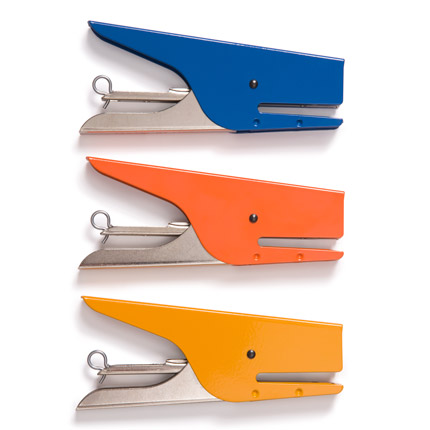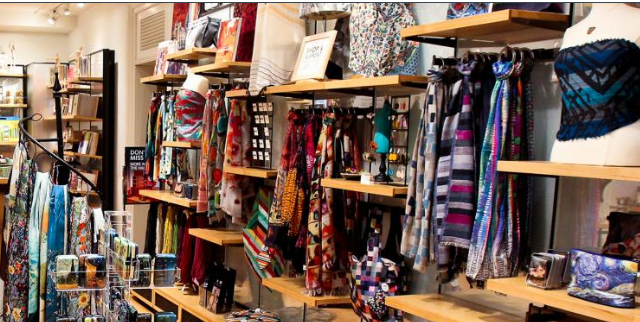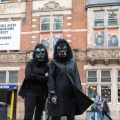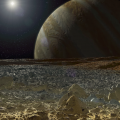Only 5, 4, 3…shopping days left! You better hurry!
If you find yourself tight on time and money this holiday season (and who isn’t?) but still need to buy a few items to complete your gift list, don’t despair. A lunchtime dash to one of the Smithsonian’s museum shops can resolve your dilemma.
The Torch took a quick telephone survey of museum shop staff around the Institution to ask what they recommend for a last-minute gift-buyer with $30 to spend. Here’s what they said:
Praveen Gooneratne, floor supervisor at the National Air and Space Museum Udvar/Hazy Center gift shop, recommends the plastic model airplanes that you assemble yourself, specifically the SR-71, B-29 and P51. “They tend to be between $15 to $30 and are a popular item here at the Udvar/Hazy Museum Shop,” he says. “We also have a t-shirt and sweater that celebrate the 15th anniversary of the Apollo 11 moon landing.”
If you commute in and out of Union Station the National Postal Museum shop is an easy side stop. “We just got in a new ornament that shows a classic vehicle from the Postal Museum collection: the Ford Model T Snowbird,” equipped with skis that replaced the front tires and caterpillar treads that wrapped around the back tires, says Hareg Berhanu at the National Postal Museum museum shop. “It is engraved on the back “1921 National Postal Museum” and comes in a nice box. Sometime you don’t know what to buy for people, this is a great item that I think is very nice.”

This 1921 Ford Model-T was owned by rural carrier Harold Crabtree of Central Square, New York. While Crabtree was able to use the car for his daily rounds most of the year, snowy days were an annual challenge. While many carriers held onto their horses and sleds for winter deliveries, Crabtree decided to try something new. After suffering through a few winters of using his back-up horses and sled instead of the car, he decided to buy the Model-T snowmobile attachment kit advertised as the “mailman’s special.” The kit included skis that replaced the front tires and caterpillar treads that wrapped around the back tires. (Courtesy Smithsonian’s National Postal Museum)

This ornament from the National Postal Museum commemorates the 1921 Model T Snowbird from its collections.
“Of course it depends on who you are buying a gift for,” says Annie Bolduc, manager at the Natural History Museum shop. For adults on your list she recommends her museum’s amber jewelry and brooches carved in the shape of animals and insects that run $18 and up. “We have regular customers who come in here every year to pick out brooches,” she says. “Amber brooches are something we’ve carried a long time; there are the old favorites, as well as new shapes that vary from year to year—butterflies, bees, etc.”
Over the years, Bolduc adds, she has bought a number of scarves from the NMNH museum selection as gifts for friends and family.

Baltic Amber Honeybee Pin available at the National Museum of Natural History gift shop.
For kids, Bolduc says “plush animals are popular year round. My favorite is the black jaguar. It’s not something that you find everywhere and it is cute and soft and well made. I’m also a big fan of the plush narwhals which come in two sizes. Again, it’s something here at the Natural History Museum that you don’t find everywhere.”
Going to a family gathering or visiting friends during the holidays? The ornaments fashioned to resemble the National Museum of African American History and Culture make a great gift, says Richard Dixon, of the NMAAHC museum shop. “I take these as gifts whenever I am going over to someone’s house.”
Of course, you can never go wrong with jewelry, he adds. “We have a great selection of jewelry here, as well as lapel pins of the museum and other assorted types of pins and brooches. NMAAHC also has a great selection of books. It all depends on who you are buying for,” Dixon adds.
At the American Indian Museum shop on the Mall, manager Rachel Seely says “we have a really good assortment of hand-made ornaments.” For her, the gourd ornaments from Peru carved to look like owls stand out. “They are really pretty. Gourd carving is a tradition among the native peoples in the Andes and these ornaments come with a nice provenance card,” she says.

Gourds carved and colored by Peruvian artists to look like tiny owls are available at the National Museum of the American Indian gift shop on the Mall.
NMAI also has a wide selection of stunning handmade, native jewelry, such as men’s bolo ties, and gender neutral rings and cuff bracelets, Seely says. For her nieces and nephews who live in Texas, Seeley sends a selection of the NMAI museum shop’s traditional native musical instruments—pretty flutes, macarenas, hide-skin drums. “They think I am the greatest aunt,” she says.
In New York City at the Cooper-Hewitt National Design Museum, Antonio Delzalle says you’ll have to stretch your budget a bit for his favorite item: the life straw (under $50). “It’s basically a straw with a filter that you can use in the outdoors to drink from any body of water and make sure you are drinking clean water. It’s one of my favorite things here because we are a design museum and the life straw is functional and accessible.”
A second item Delzalle favors is the whale stapler, an iconic staple gun with a whale motif designed in 1974 that is $24. Steel mugs made for camping that say “Cooper-Hewitt” in large letters on the outside are another great design.

Whale staplers from Cooper Hewitt, Smithsonian Design Museum in New York make perfect stocking stuffers for the Milton in your office.
At the Hirshhorn Museum Shop, Touissant Rhone recommends the selection of stylish tote bags for $24. “Our most popular are the Andy Warhol “Banana” and “Campbells Soup” totes,” he says. Other popular gift ideas are the distinctive Piet Mondrian tote bags and the History of Art tote.
The Freer/Sackler gift shop has some very nice multicolor Turkish bowls, trivets and coasters that are food friendly and hand made. They also have 100 percent silk scarves that are made from recycled saris. Those are a nice gift as well.”

Brightly enameled bowls from Turkey are food-safe and the perfect accent for a holiday table. Available at the Freer and Sackler gift shop.
At the African Art museum are “trade beads and little animal ornaments to hang on a tree,” says Laquisha Jones. Her favorite items are a bit out of our last-minute price range, but too cool to resist: new “elephant sculptures made out of gas containers. Elephants come in two sizes, and there are other animals as well owl, turtle and hippo.”
Without mentioning any specific items, American Art/Portrait Gallery museum shop manager Wendy Brown recommends buying gifts that will keep people—both kids and adults–engaged with each other and off of their cell phone, TV and computer screens. “One reason people come to art museums is so they can get out and do something with their family and be engaged with each other and use their minds in creative ways.”
The American Art/Portrait Gallery museum shop is filled with gifts that allow people to do just that. “Art supplies make excellent gifts. We have games that multiple people can play, jigsaw puzzles, and books that help people engage with each other such as one on how to throw a painting party, and another on how to create cakes that look like art.”

The American Art Museum/National Portrait Gallery offers a wealth of choices for the artistically inclined.
Whether you’re shopping for gifts for others or for yourself (and it’s tempting!) the Smithsonian really does offer just about everything under the sun
Posted: 18 December 2018





